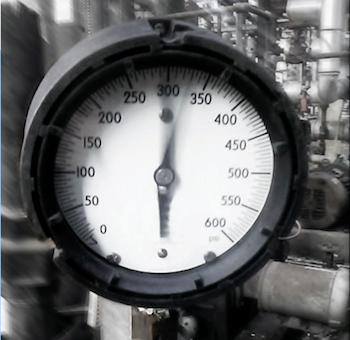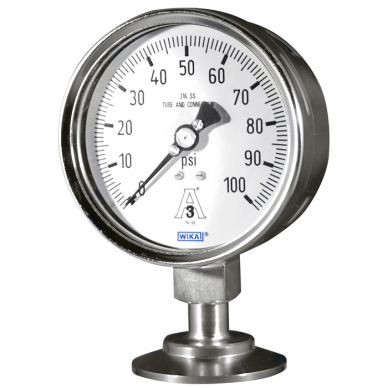
The CEO of a personal care company contacted WIKA USA about problems reading a pressure gauge due to severe pressure fluctuations and pointer flutter. Our pressure expert immediately came up with a solution to dampen extreme pulsations in pressure applications, to the delight of this new customer.

pointer flutter
Many industrial processes experience pulsation, defined as regular instances of rapid pressure changes in the media. This condition makes it difficult to read a standard Bourdon tube gauge, as the pointer flutters wildly. If a gauge undergoes prolonged pulsation, the internal components begin to wear down from constant movement, which shortens the instrument’s service life. In extreme cases, the pointer breaks or detaches, and the entire gauge loses functionality.
Problem: How to Get Accurate Pressure Readings in a Process with Pulsation
A specialized company in the personal care space was having this exact problem with its pressure gauges. Technicians could not get accurate readings on a sanitary process that experiences regular pressure fluctuations. The details:
- Process medium: a shear thinning fluid being pumped at 30 gpm at around 100 psi, with an estimated kinetic viscosity of 7700 cP
- Goal: to measure the backpressure experienced by a cavitating positive displacement pump
- Problem: a pressure fluctuation of 2 to 4 Hz, making it difficult to read the gauge
When the CEO reached out to the original gauge manufacturer for recommendations to solve his pulsation issue, he was told that a dampened movement gauge would take care of the problem. Unfortunately, that did not make a difference in his process, and the pointer continued to fluctuate wildly. This solution didn’t work because while a dampened movement takes care of vibration-induced pointer flutter, it is not the answer for severe pulsation since it does not address the root cause.
Knowing there had to be a better solution, the CEO started researching online. He was thrilled to come across 8 Common Reasons for Gauge Failure on the WIKA USA blog and immediately reached out to Hardy Orzikowski, product manager of mechanical pressure instrumentation.
Solution to Dampen Pressure Pulsations: Liquid Fill + Protective Restrictor
Hardy, a pressure expert with more than three decades of industry knowledge, is a pro at helping customers select pressure gauges for their unique applications. After listening to the CEO, who also required a sanitary connection, Hardy knew exactly what to recommend:
- Liquid filling to lubricate the movement and dampen the pointer from vibrations and pulsations
- Sanitary gauge assembly with integrated diaphragm seal
- Internal restrictor to further dampen the pulsation being transmitted to the gauge

M933.3A assembled diaphragm seal for sanitary applications
Convinced that this solution would work, the CEO bought and installed a M933.3A sanitary diaphragm seal assembly with an internal restrictor to drastically reduce the effect of pulsations on the pressure gauge. He made an initial production run with this new gauge for severe pressure pulsation, and it performed superbly. He made a second run just to make sure the first time wasn’t a fluke, and the results were exactly the same.
“Based on the description of the problem I faced, Hardy quickly and unerringly selected the proper gauge for me,” the CEO said. “The gauge worked perfectly from the start – no pulsation, no fluctuation. The needle was as steady as a baby in the cradle!”
WIKA’s recommendation to use an internal restrictor in combination with a glycerin case filling made such a difference in the process monitoring that the CEO was able to make further improvements – some rather significant – throughout the production line.
“I’m very glad I read your blog!” he told Hardy.
WIKA USA, Part of Your Business
Hardy Orzikowski is not the only expert at WIKA USA who listens to customers and helps solve their most challenging issues. Our entire team is dedicated to finding the perfect measuring instruments for a variety of industries. For all your measurement needs – pressure, temperature, level, force, flow, calibration, or SF6 gas – contact us for personalized recommendations and solutions.

